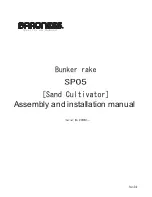
63
Air conditioning equipment must be maintained by profes-sional
technicians, whilst routine checks can be carried out locally by
specialised technicians. See the standard EN 378-4.
Simple preventive maintenance will allow you to get the best
performance from your HVAC unit:
-
Improved cooling performance
-
Reduced power consumption
-
Prevention of accidental component failure
-
Prevention of major time-consuming and costly inter-
ventions
-
Protection of the environment.
There are five maintenance levels for HVAC units, as defined by
the AFNOR X60-010 standard.
13.1 - Level 1 maintenance
See note “Any deviation or non-observation ...” in chapter 13.3 -
“Level 3 (or higher) maintenance”. Simple procedure can be carried
out by the user:
-
Visual inspection for oil traces (sign of a refrigerant leak)
-
Air heat exchanger (condenser) cleaning - see chapter
13.6.1 - “Level 1”.
-
Check for removed protection devices, and badly closed
doors/covers
-
Check the unit alarm report when the unit does not work.
Refer to the 30XB/30XAS/30XW Touch Pilot control
manual for a more detailed explanation.
General visual inspection for any signs of deterioration.
13.2 - Level 2 maintenance
See note “Any deviation or non-observation ...” in the ext column.
This level requires specific know-how in the electrical, hydraulic
and mechanical fields. It is possible that these skills are available
locally: Existence of a maintenance service, industrial site,
specialised subcontractor. In these cases, the following
maintenance operations are recommended.
Carry out all level 1 operations, then:
-
At least once a year tighten the power circuit electrical
connections (see table 13.4).
-
Check and re-tighten all control/command connections,
if required (see table 13.4).
-
Check the differential switches for correct operation every
6 months (free-cooling option 118A).
-
Remove the dust and clean the interior of the control
boxes, if required.
-
Check the presence and the condition of the electrical
protection devices.
-
Check the correct operation of all heaters.
-
Replace the fuses every 3 years or every 15000 hours
(age-hardening).
-
Replace the control box cooling fans used with option 22
(with designation EF22_) every five years.
-
Check the height of the anti-vibration mountings (located
between the compressor rails and the unit chassis) after
5 years of operation, and then each year. When the total
minimum height of the mountings is less than 25 mm
replace the mountings.
-
Check the water connections.
-
Purge the water circuit.
-
Clean the water filter.
-
Fully clean the condensers with a low-pressure jet and a
bio-degradable cleaner (counter-current cleaning - see
chapter 13.6.2 - “Level 2”).
-
Replace the stuffing box packing of the pump after 10000
hours of operation.
-
Check the unit operating parameters and compare them
with previous values.
-
Keep and maintain a maintenance sheet, attached to
each HVAC unit.
-
Check the correct operation of the capacitor (power factor
correction option 231).
All these operations require strict observation of adequate safety
measures: Individual protection garments, compliance with all
industry regulations, compliance with applicable local regulations
and using common sense.
13.3 - Level 3 (or higher) maintenance
NOTE: Any deviation or non-observation of these mainte-nance
criteria will render the guarantee conditions for the HVAC unit
null and void, and the manufacturer, Carrier SCS will no longer
be held responsible.
The maintenance at this level requires specific skills/approval/
tools and know-how and only the manufacturer, his representative
or authorised agent are permitted to carry out these operations.
These maintenance operations concern for example:
-
A major component replacement (compressor, evapo-
rator)
-
Any intervention on the refrigerant circuit (handling
refrigerant)
-
Changing of parameters set at the factory (application
change)
-
Removal or dismantling of the HVAC unit
-
Any intervention due to a missed established mainte-
nance operation
-
Any intervention covered by the warranty.
13.4 - Tightening torques for the main electrical
connections
13.4.1 - Tightening torques for the main electrical connections
Screw type
Use
Value
(N.m)
(N·m)
Metal screw D = 4.8
Condensing module, housing
supports
4,2
Screw H M8
Condensing module, compressor
fixing
18
Taptite screw M10
Condensing module, chassis -
structure fixing, control box fixings,
compressor fixings, oil separator
fixing
30
Taptite screw M6
Piping support, cowling
7
Screw H M8
Piping clip
12
Screw H M6
Piping clip
10
Nut H M10
Compressor chassis
30
Nut H M10
Hydraulic pump chassis
30
Screw H M8
Filter drier cover
35
Screw H M12
Economiser port flange
40
Screw H M16
Oil separator flanges, suction
flanges
110
Screw H M16
Heat exchanger water boxes
190
Screw H M20
Suction flanges
190
Nut 5/8 ORFS
Oil line
65
Nut 3/8 ORFS
Oil line
26
Nut H M12/M16
Victaulic collars on suction piping 60/130
Self-locking Nut M16
Compressor fixing
30
ATTENTION: The tightening of the connections at the
compressor terminals requires special precautions. Please
refer to the chapter below.
13 - STANDARD MAINTENANCE
Содержание AquaForce 30XB series
Страница 69: ......








































